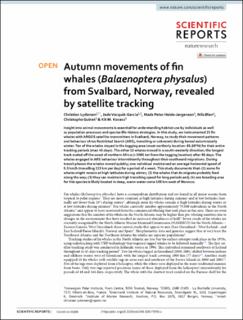| dc.contributor.author | Lydersen, Christian | |
| dc.contributor.author | Vacquie-Garcia, Jade | |
| dc.contributor.author | Heide-Jørgensen, Mads-Peter | |
| dc.contributor.author | Øien, Nils Inge | |
| dc.contributor.author | Guinet, Christophe | |
| dc.contributor.author | Kovacs, Kit M. | |
| dc.date.accessioned | 2021-02-16T09:46:46Z | |
| dc.date.available | 2021-02-16T09:46:46Z | |
| dc.date.created | 2021-01-29T11:59:55Z | |
| dc.date.issued | 2020 | |
| dc.identifier.citation | Scientific Reports. 2020, 10 1-13. | en_US |
| dc.identifier.issn | 2045-2322 | |
| dc.identifier.uri | https://hdl.handle.net/11250/2728284 | |
| dc.description.abstract | Insight into animal movements is essential for understanding habitat use by individuals as well as population processes and species life-history strategies. In this study, we instrumented 25 fin whales with ARGOS satellite-transmitters in Svalbard, Norway, to study their movement patterns and behaviour (Area Restricted Search (ARS), transiting or unknown) during boreal autumn/early winter. Ten of the whales stayed in the tagging area (most northerly location: 81.68°N) for their entire tracking periods (max 45 days). The other 15 whales moved in a south-westerly direction; the longest track ended off the coast of northern Africa (> 5000 km from the tagging location) after 96 days. The whales engaged in ARS behaviour intermittently throughout their southward migrations. During transit phases the whales moved quickly; one individual maintained an average horizontal speed of 9.3 km/h (travelling 223 km per day) for a period of a week. This study documents that: (1) some fin whales might remain at high latitudes during winter; (2) the whales that do migrate probably feed along the way; (3) they can maintain high transiting speed for long periods and; (4) one breeding area for this species is likely located in deep, warm water some 100 km west of Morocco. | en_US |
| dc.language.iso | eng | en_US |
| dc.title | Autumn movements of fin whales (Balaenoptera physalus) from Svalbard, Norway, revealed by satellite tracking | en_US |
| dc.type | Peer reviewed | en_US |
| dc.type | Journal article | en_US |
| dc.description.version | publishedVersion | en_US |
| dc.source.pagenumber | 1-13 | en_US |
| dc.source.volume | 10 | en_US |
| dc.source.journal | Scientific Reports | en_US |
| dc.identifier.doi | 10.1038/s41598-020-73996-z | |
| dc.identifier.cristin | 1882259 | |
| dc.relation.project | Norges forskningsråd: 244488 | en_US |
| dc.source.articlenumber | 16966 | en_US |
| cristin.ispublished | true | |
| cristin.fulltext | original | |
| cristin.qualitycode | 1 | |
